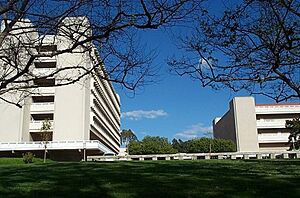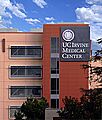University of California, Irvine facts for kids
 |
|
| Motto | Fiat lux (Latin) |
|---|---|
|
Motto in English
|
"Let there be light" |
| Type | Public land-grant research university |
| Established | October 4, 1965 |
|
Parent institution
|
University of California |
| Accreditation | WSCUC |
|
Academic affiliations
|
|
| Endowment | $899.357 million (2024) |
| Budget | $6.7 billion (2024) |
| Chancellor | Howard Gillman |
| Provost | Hal Stern |
|
Academic staff
|
5,343 (2024) |
|
Administrative staff
|
6,426 (2019) |
| Students | 37,297 (2024) |
| Undergraduates | 30,204 (2024) |
| Postgraduates | 7,093 (2024) |
| Location |
,
,
United States
33°38′44″N 117°50′33″W / 33.64556°N 117.84250°W |
| Campus | Large Suburb, 1,582 acres (640 ha) |
| Other campuses | Orange |
| Newspaper | New University |
| Colors | Blue and gold |
| Nickname | Anteaters |
|
Sporting affiliations
|
|
| Mascot | Peter the Anteater |
 |
|
The University of California, Irvine (often called UCI or UC Irvine) is a public research university in Irvine, California. It is one of the ten schools in the University of California system. UCI offers 87 degrees for undergraduate students and 129 degrees for graduate students. As of 2024, about 37,000 students were enrolled at the university.
UCI is known for its high level of research. It is a member of the prestigious Association of American Universities. The university also runs the UC Irvine Medical Center, a large hospital where students learn about health care. UCI is also famous for being the first university in the United States to have a department for Earth System Science.
The university's sports teams are called the UC Irvine Anteaters. They compete in NCAA Division I. The Anteaters have won 28 national championships in nine different sports. Many famous people, including Nobel Prize winners and Olympic athletes, have studied or worked at UCI.
Contents
History of the University
How UCI Got Started
In the 1950s, the University of California system knew it needed more campuses. This was because many more students were expected to enroll after the post-war baby boom. They decided to build a new campus in the Los Angeles area. The location chosen was Irvine Ranch, a large area of farmland in Orange County.
The Irvine Company, which owned the land, sold 1,000 acres to the university for only one dollar. The university was named "Irvine" after James Irvine, the man who once owned the ranch. This was unusual because most UC campuses are named after the city they are in, but the city of Irvine did not exist yet.

On June 20, 1964, U.S. President Lyndon B. Johnson officially dedicated the land for UC Irvine. The campus opened on October 4, 1965, with about 1,600 students and 119 professors. Many buildings were still being built at the time. The first graduation ceremony was held in 1966 for just fourteen students.
Growing and Changing
The university hired architect William Pereira to design the campus. He planned for the university to be the center of a new community. The city of Irvine was officially established in 1971. Today, UCI is a major employer in Orange County and has a big impact on the local economy.
The first chancellor, Daniel G. Aldrich, wanted the campus to have many plants that grow in a Mediterranean climate. He felt this would make the campus beautiful and be good for the environment.
In 1967, the California College of Medicine became part of UC Irvine. Instead of building a new hospital on campus, the university bought a medical center in the nearby city of Orange. This became the UC Irvine Medical Center.
The UCI Campus
The main part of the UCI campus is designed like a circle. In the very center is a large park called Aldrich Park. A road called Ring Mall goes all the way around the park. The main school buildings are located along this road.
Aldrich Park and Ring Mall
Aldrich Park is a beautiful, large park with over 11,000 trees. It is a popular spot for students to relax, study, and attend events. One famous event is "Wayzgoose," a fun festival with a medieval theme that happens every year.
Ring Mall is a pedestrian road that is exactly one mile long. It circles Aldrich Park and connects all the main schools and libraries. This makes it easy for students and teachers to walk around the campus.
Campus Buildings and Architecture
The first buildings on campus were designed by a team led by William Pereira. They have a unique, futuristic look. Many of these early buildings were designed to look like they are sitting on pedestals, with white railings that look like the deck of a ship.

In the late 1980s, the campus started to grow again. New buildings were designed by famous architects like Frank Gehry. These newer buildings have a more colorful and modern style. This created a mix of different architectural styles on campus.
One of the most recent buildings is the Humanities Gateway, which opened in 2009. It has a curved design and is very eco-friendly. It was the first building on campus to receive a LEED Platinum certification for its green design.
| [[Image:{{{2}}}|{{{3}}}px|]] | [[Image:{{{4}}}|{{{5}}}px|]] | |
Libraries and Places to Study
UCI has several large libraries where students can find books and study. The main libraries are Langson Library and the Science Library. Langson Library has resources for arts, humanities, and business. The Science Library is one of the largest science and medical libraries in the country.
Besides the main libraries, there are many other places to study. The Gateway Study Center is a popular spot that is open almost 24 hours a day. The UCI Student Center also has study areas, food courts, and auditoriums. Students can also study in Aldrich Park or in the plazas outside their school buildings.
Academics at UCI
UC Irvine is made up of different schools, each focusing on a specific area of study. As of the 2023–2024 school year, there were fifteen schools. Some of the schools include:
- Claire Trevor School of the Arts
- Charlie Dunlop School of Biological Sciences
- Paul Merage School of Business
- Henry Samueli School of Engineering
- Donald Bren School of Information & Computer Sciences
- School of Law
- School of Medicine
Health Care Education
The School of Medicine and the Sue & Bill Gross School of Nursing are part of UCI's health sciences. The UC Irvine Medical Center is a top-ranked hospital where students get hands-on experience. The School of Medicine is very competitive, accepting only a small percentage of applicants each year.
| [[Image:{{{2}}}|{{{3}}}px|]] | [[Image:{{{4}}}|{{{5}}}px|]] | |
University Rankings
UCI is considered one of the top universities in the world.
- U.S. News & World Report ranked UCI as the 9th best public university in the U.S. for 2024.
- Forbes magazine ranked UCI 3rd in its "Best Value Colleges" list in 2019.
- Sierra Magazine has often ranked UCI as one of its "Coolest Schools" for being environmentally friendly.
- Many of UCI's graduate programs, such as Criminology, English, and Computer Science, are ranked among the best in the country.
Student Life at UCI
UCI has a diverse student body. Students come from all over California and from many different countries. There are over 600 student clubs and organizations on campus, so there is something for everyone.
Living on Campus
UCI offers several housing options for students. About half of all students live on campus. The university guarantees housing for two years to new undergraduate students.
- Middle Earth: This is a housing complex for first-year students. The buildings are named after places and characters from J.R.R. Tolkien's The Lord of the Rings. It is located near the center of campus.

- Mesa Court: This is another housing community for freshmen. It has 29 classic halls and three large towers. It is located near the School of the Arts.
- East Campus Student Housing: For older students, there are several apartment communities on campus. These offer more independent living while still being close to classes.
The Anteater Mascot
UCI's mascot is Peter the Anteater. In 1965, students were asked to vote for a mascot. Three students suggested the anteater, and it won the election. The anteater was a unique and fun choice compared to other options like a seahawk or a bison.
Peter the Anteater is a very popular mascot. He often appears at sports games and campus events. Students have a special hand signal called "Rip 'Em 'Eaters" to show their school spirit.
UCI Sports
UCI's sports teams, the Anteaters, are very successful. They compete in NCAA Division I. The university has won 28 national championships in sports like water polo, baseball, and volleyball.
- Men's Volleyball: The men's volleyball team is one of the best in the country. They won four national championships in 2007, 2009, 2012, and 2013.
- Baseball: The baseball team won two national championships in 1973 and 1974. They have also competed in the College World Series several times.
- Men's Basketball: In 2019, the men's basketball team won its first-ever game in the NCAA tournament, which was a big achievement for the school.

Famous People from UCI
Many successful people have graduated from or worked at UCI. These include astronauts, athletes, actors, and scientists.
Five people connected to UCI have won the Nobel Prize. In 1995, Professor Frank Sherwood Rowland and researcher Mario Molina won the Nobel Prize in Chemistry. They discovered that certain chemicals were harming the Earth's ozone layer. That same year, Professor Frederick Reines won the Nobel Prize in Physics for his work discovering a tiny particle called the neutrino.
Seven people from UCI have also won the Pulitzer Prize, a major award for writing and journalism. Famous alumni include Michael Chabon, who wrote the award-winning book The Amazing Adventures of Kavalier & Clay.
Images for kids
-
Rowland Hall, named after Frank "Sherry" Rowland, who won a Nobel Prize in Chemistry for the discovery that CFCs contribute to ozone depletion. It is a National Historic Chemical Landmark.
See also
 In Spanish: Universidad de California en Irvine para niños
In Spanish: Universidad de California en Irvine para niños
- Anteater Recreation Center
- Center for Chemistry at the Space-Time Limit




























